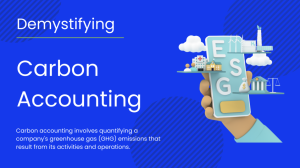Carbon accounting is the process of measuring a company’s greenhouse gas (GHG) emissions, which are released from its activities and operations. These emissions, including carbon dioxide (CO2), methane (CH4), and nitrous oxide (N2O), are the main contributors to climate change.
Why Carbon Accounting Matters
Carbon accounting enables businesses to understand their environmental impact and make informed decisions to reduce it. This is crucial as industries and governments work towards net zero emissions targets. Additionally, carbon accounting helps companies comply with increasingly stringent regulations, enhances their reputation, and can even lead to cost savings through improved energy efficiency.
Getting Started with Carbon Accounting
The first step for organizations new to carbon accounting is a baseline emissions assessment. This involves identifying and quantifying all emission sources, both direct (e.g., burning fossil fuels) and indirect (e.g., electricity consumption, supply chain emissions).
Understanding the GHG Protocol
The GHG Protocol is the most widely used standard for carbon accounting. It provides guidelines on what to include and how to calculate emissions, even when perfect data is not available. The protocol categorizes emissions into three scopes:
- Scope 1: Direct emissions from owned or controlled sources.
- Scope 2: Indirect emissions from purchased electricity, heat, or cooling.
- Scope 3: All other indirect emissions in the value chain, often the most significant category.
Emissions are usually expressed in CO2e, a standardized unit that reflects the global warming potential of different gases. These emissions, including carbon dioxide (CO2), methane (CH4), and nitrous oxide (N2O), are the main contributors to climate change.
Carbon Accounting Software
While the GHG Protocol provides a framework, the actual calculation and management of emissions data can be complex. This is where carbon accounting software comes in. These tools automate data collection, streamline calculations, and generate reports, making carbon accounting more efficient and accurate.
Choosing the Right Software
When selecting carbon accounting software, consider your company’s specific needs and goals, the software’s measurement and reporting capabilities, data integration features, ease of use, alignment with recognized standards, scalability, cost, and data security.
The Future of Carbon Accounting
As businesses prioritize sustainability, carbon accounting software will play an increasingly important role. These tools not only help companies measure and report emissions but also enable them to make strategic decisions, reduce their carbon footprint, and contribute to a more sustainable future.
For businesses seeking a user-friendly and comprehensive carbon accounting solution, HERMESNET offers free 365-day access to its software. This allows companies to experience the benefits of streamlined emissions tracking and reporting firsthand, empowering them to take meaningful action towards a sustainable future.
#CarbonAccounting #Sustainability #ESG (Environmental, Social, and Governance) #ClimateChange #NetZero #GreenhouseGasEmissions #CorporateSustainability #EnvironmentalImpact #CarbonFootprint #SustainableBusiness

